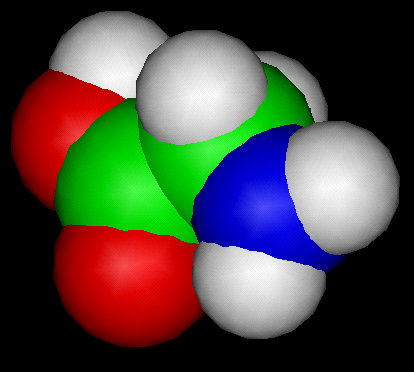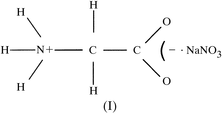Source(google.com.pk)
Cleavage Images Biography
Glycine was discovered in 1820, by Henri Braconnot who boiled gelatin with sulfuric acid.[5]
Glycine is manufactured industrially by treating chloroacetic acid with ammonia:[6]
ClCH2COOH + 2 NH3 → H2NCH2COOH + NH4Cl
About 15 million kg are produced annually in this way.[7]
In the USA (by GEO Specialty Chemicals, Inc.) and in Japan (by Shoadenko), glycine is produced via the Strecker amino acid synthesis.[8][9]
There are two producers of glycine in the United States: Chattem Chemicals, Inc., a subsidiary of Mumbai-based Sun Pharmaceutical, and GEO Specialty Chemicals, Inc., which purchased the glycine and naphthalene sulfonate production facilities of Hampshire Chemical Corp, a subsidiary of Dow Chemical.[8][10]
Chattem's manufacturing process ("MCA" process) occurs in batches and results in a finished product with some residual chloride but no sulfate, while GEO’s manufacturing process is considered a semi-batch process and results in a finished product with some residual sulfate but no chloride.
Its pKA values are 2.35 and 9.78, so above pH 9.78, most of the glycine exists as the anionic amine, H2NCH2CO2-. Below pH 2.35, its solutions contain mostly the cationic carboxylic acid H3N+CH2CO2H. Its isoelectric point (pI) is 6.06.
Glycine exists in zwitterionic form in solution. In this form, the partial charges on different atoms as determined using Gasteiger charge method are given as follows: N (+0.2358), H (attached to N) (+0.1964), alpha-C (+0.001853), H (attached to alpha-C) (+0.08799), carbonyl C (+0.085) and carbonyl O (-0.5445).
Glycine is not essential to the human diet, as it is biosynthesized in the body from the amino acid serine, which is in turn derived from 3-phosphoglycerate. In most organisms, the enzyme Serine hydroxymethyltransferase catalyses this transformation via the cofactor pyridoxal phosphate:[11]
serine + tetrahydrofolate → glycine + N5,N10-Methylene tetrahydrofolate + H2O
In the liver of vertebrates, glycine synthesis is catalyzed by glycine synthase (also called glycine cleavage enzyme). This conversion is readily reversible:[11]
CO2 + NH4+ + N5,N10-Methylene tetrahydrofolate + NADH + H+ → Glycine + tetrahydrofolate + NAD+
Glycine is coded by codons GGU, GGC, GGA and GGG. Most proteins incorporate only small quantities of glycine. A notable exception is collagen, which contains about 35% glycine
Glycine is degraded via three pathways. The predominant pathway in animals and plants involves the glycine cleavage enzyme[11]
Glycine + tetrahydrofolate + NAD+ → CO2 + NH4+ + N5,N10-Methylene tetrahydrofolate + NADH + H+
In the second pathway, glycine is degraded in two steps. The first step is the reverse of glycine biosynthesis from serine with serine hydroxymethyl transferase. Serine is then converted to pyruvate by serine dehydratase.[11]
In the third pathway of glycine degradation, glycine is converted to glyoxylate by D-amino acid oxidase. Glyoxylate is then oxidized by hepatic lactate dehydrogenase to oxalate in an NAD+-dependent reaction.[11]
The half-life of glycine and its elimination from the body varies significantly based on dose. In one study, the half-life was between 0.5 and 4.0 hours.
Glycine is an inhibitory neurotransmitter in the central nervous system, especially in the spinal cord, brainstem, and retina. When glycine receptors are activated, chloride enters the neuron via ionotropic receptors, causing an Inhibitory postsynaptic potential (IPSP). Strychnine is a strong antagonist at ionotropic glycine receptors, whereas bicuculline is a weak one. Glycine is a required co-agonist along with glutamate for NMDA receptors. In contrast to the inhibitory role of glycine in the spinal cord, this behaviour is facilitated at the (NMDA) glutaminergic receptors which are excitatory.[14] The LD50 of glycine is 7930 mg/kg in rats (oral),[15] and it usually causes death by hyperexcitability.
There is some evidence showing that 3000 milligrams of glycine before bedtime improves sleep quality
In the US, glycine is typically sold in two grades: United States Pharmacopeia (“USP”), and technical grade. Most glycine is manufactured as USP grade material for diverse uses. USP grade sales account for approximately 80 to 85 percent of the U.S. market for glycine.
Pharmaceutical grade glycine is produced for some pharmaceutical applications, such as intravenous injections, where the customer’s purity requirements often exceed the minimum required under the USP grade designation. Pharmaceutical grade glycine is often produced to proprietary specifications and is typically sold at a premium over USP grade glycine.
Technical grade glycine, which may or may not meet USP grade standards, is sold for use in industrial applications; e.g., as an agent in metal complexing and finishing. Technical grade glycine is typically sold at a discount to USP grade glycine
Other markets for USP grade glycine include its use an additive in pet food and animal feed. For humans, glycine is sold as a sweetener/taste enhancer. Food supplements and protein drinks contain glycine. Certain drug formulations include glycine to improve gastric absorption of the drug.
Glycine is an intermediate in the synthesis of a variety of chemical products. It is used in the manufacture of the herbicide glyphosate. Glyphosate is a non-selective systemic herbicide used to kill weeds, especially perennials and broadcast or used in the cut-stump treatment as a forestry herbicide. Initially, glyphosate was sold only by Monsanto under the tradename Roundup, but is no longer under patent.










Cleavage Images Biography
Glycine was discovered in 1820, by Henri Braconnot who boiled gelatin with sulfuric acid.[5]
Glycine is manufactured industrially by treating chloroacetic acid with ammonia:[6]
ClCH2COOH + 2 NH3 → H2NCH2COOH + NH4Cl
About 15 million kg are produced annually in this way.[7]
In the USA (by GEO Specialty Chemicals, Inc.) and in Japan (by Shoadenko), glycine is produced via the Strecker amino acid synthesis.[8][9]
There are two producers of glycine in the United States: Chattem Chemicals, Inc., a subsidiary of Mumbai-based Sun Pharmaceutical, and GEO Specialty Chemicals, Inc., which purchased the glycine and naphthalene sulfonate production facilities of Hampshire Chemical Corp, a subsidiary of Dow Chemical.[8][10]
Chattem's manufacturing process ("MCA" process) occurs in batches and results in a finished product with some residual chloride but no sulfate, while GEO’s manufacturing process is considered a semi-batch process and results in a finished product with some residual sulfate but no chloride.
Its pKA values are 2.35 and 9.78, so above pH 9.78, most of the glycine exists as the anionic amine, H2NCH2CO2-. Below pH 2.35, its solutions contain mostly the cationic carboxylic acid H3N+CH2CO2H. Its isoelectric point (pI) is 6.06.
Glycine exists in zwitterionic form in solution. In this form, the partial charges on different atoms as determined using Gasteiger charge method are given as follows: N (+0.2358), H (attached to N) (+0.1964), alpha-C (+0.001853), H (attached to alpha-C) (+0.08799), carbonyl C (+0.085) and carbonyl O (-0.5445).
Glycine is not essential to the human diet, as it is biosynthesized in the body from the amino acid serine, which is in turn derived from 3-phosphoglycerate. In most organisms, the enzyme Serine hydroxymethyltransferase catalyses this transformation via the cofactor pyridoxal phosphate:[11]
serine + tetrahydrofolate → glycine + N5,N10-Methylene tetrahydrofolate + H2O
In the liver of vertebrates, glycine synthesis is catalyzed by glycine synthase (also called glycine cleavage enzyme). This conversion is readily reversible:[11]
CO2 + NH4+ + N5,N10-Methylene tetrahydrofolate + NADH + H+ → Glycine + tetrahydrofolate + NAD+
Glycine is coded by codons GGU, GGC, GGA and GGG. Most proteins incorporate only small quantities of glycine. A notable exception is collagen, which contains about 35% glycine
Glycine is degraded via three pathways. The predominant pathway in animals and plants involves the glycine cleavage enzyme[11]
Glycine + tetrahydrofolate + NAD+ → CO2 + NH4+ + N5,N10-Methylene tetrahydrofolate + NADH + H+
In the second pathway, glycine is degraded in two steps. The first step is the reverse of glycine biosynthesis from serine with serine hydroxymethyl transferase. Serine is then converted to pyruvate by serine dehydratase.[11]
In the third pathway of glycine degradation, glycine is converted to glyoxylate by D-amino acid oxidase. Glyoxylate is then oxidized by hepatic lactate dehydrogenase to oxalate in an NAD+-dependent reaction.[11]
The half-life of glycine and its elimination from the body varies significantly based on dose. In one study, the half-life was between 0.5 and 4.0 hours.
Glycine is an inhibitory neurotransmitter in the central nervous system, especially in the spinal cord, brainstem, and retina. When glycine receptors are activated, chloride enters the neuron via ionotropic receptors, causing an Inhibitory postsynaptic potential (IPSP). Strychnine is a strong antagonist at ionotropic glycine receptors, whereas bicuculline is a weak one. Glycine is a required co-agonist along with glutamate for NMDA receptors. In contrast to the inhibitory role of glycine in the spinal cord, this behaviour is facilitated at the (NMDA) glutaminergic receptors which are excitatory.[14] The LD50 of glycine is 7930 mg/kg in rats (oral),[15] and it usually causes death by hyperexcitability.
There is some evidence showing that 3000 milligrams of glycine before bedtime improves sleep quality
In the US, glycine is typically sold in two grades: United States Pharmacopeia (“USP”), and technical grade. Most glycine is manufactured as USP grade material for diverse uses. USP grade sales account for approximately 80 to 85 percent of the U.S. market for glycine.
Pharmaceutical grade glycine is produced for some pharmaceutical applications, such as intravenous injections, where the customer’s purity requirements often exceed the minimum required under the USP grade designation. Pharmaceutical grade glycine is often produced to proprietary specifications and is typically sold at a premium over USP grade glycine.
Technical grade glycine, which may or may not meet USP grade standards, is sold for use in industrial applications; e.g., as an agent in metal complexing and finishing. Technical grade glycine is typically sold at a discount to USP grade glycine
Other markets for USP grade glycine include its use an additive in pet food and animal feed. For humans, glycine is sold as a sweetener/taste enhancer. Food supplements and protein drinks contain glycine. Certain drug formulations include glycine to improve gastric absorption of the drug.
Glycine is an intermediate in the synthesis of a variety of chemical products. It is used in the manufacture of the herbicide glyphosate. Glyphosate is a non-selective systemic herbicide used to kill weeds, especially perennials and broadcast or used in the cut-stump treatment as a forestry herbicide. Initially, glyphosate was sold only by Monsanto under the tradename Roundup, but is no longer under patent.
Cleavage Images Photos Pictures Pics Images

Cleavage Images Photos Pictures Pics Images

Cleavage Images Photos Pictures Pics Images

Cleavage Images Photos Pictures Pics Images

Cleavage Images Photos Pictures Pics Images

Cleavage Images Photos Pictures Pics Images

Cleavage Images Photos Pictures Pics Images

Cleavage Images Photos Pictures Pics Images

Cleavage Images Photos Pictures Pics Images

Cleavage Images Photos Pictures Pics Images

Cleavage Images Photos Pictures Pics Images